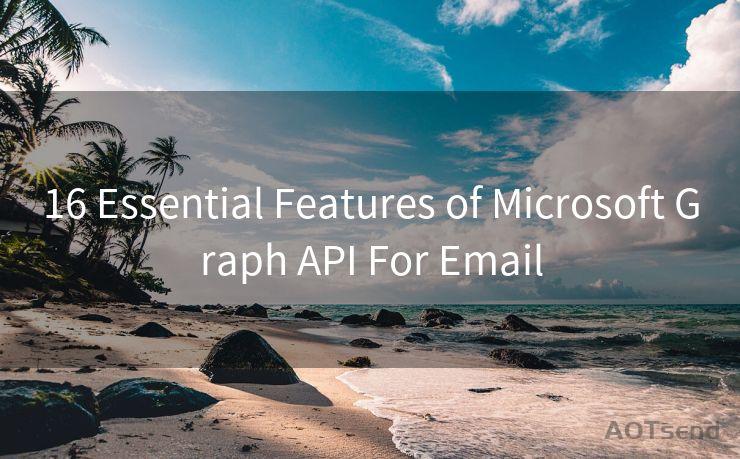16 Essential Features of Microsoft Graph API For Email




Microsoft Graph API offers a unified programmability model that allows developers to access data and intelligence in Microsoft 365, Windows 10, and Enterprise Mobility + Security. When it comes to email functionality, the Graph API provides a comprehensive set of features that empower developers to create rich and interactive email-based applications. Let's explore the 16 essential features of Microsoft Graph API for email.
1. Send and Receive Emails
With Microsoft Graph API, sending and receiving emails becomes effortless. Developers can use the API to programmatically create, send, and retrieve emails, enabling automated communication workflows within applications.
2. Access and Modify Email Properties
The API allows you to access and modify various email properties such as subject, body, attachments, and recipients. This flexibility enables developers to customize emails according to specific business requirements.
3. Manage Email Folders
Microsoft Graph API enables you to manage email folders, including creating new folders, renaming existing folders, and deleting unwanted folders. This functionality is crucial for organizing emails within a user's mailbox.
4. Search Emails
Searching for specific emails is a breeze with the Graph API. Developers can implement powerful search functionalities that filter emails based on various criteria like sender, recipient, subject, or even the body of the email.
5. Flag and Categorize Emails
Emails can be flagged or categorized using the API, making it easier for users to prioritize and manage their inboxes. This feature is particularly useful for implementing task management or email triage systems.
6. Handle Email Attachments
The Graph API simplifies the handling of email attachments. Developers can programmatically add, remove, or modify attachments, facilitating seamless file sharing and collaboration within email communications.
7. Forward and Reply to Emails
With the API, forwarding and replying to emails becomes straightforward. Applications can automate responses or forward emails to relevant parties, improving communication efficiency.
8. Manage Email Rules
Microsoft Graph API supports managing email rules, allowing developers to create automated actions based on specific email conditions. This feature enables advanced email filtering and processing capabilities.
9. Sync Emails
The API provides mechanisms to sync emails across devices and platforms, ensuring data consistency and accessibility regardless of where or how users access their emails.
10. Monitor Email Delivery
Developers can monitor email delivery status using the Graph API, ensuring that critical messages are received and acted upon in a timely manner.
11. Protect Sensitive Emails
With the API, sensitive emails can be protected with encryption or rights management policies, enhancing data security and compliance.
12. Integrate with External Systems
Microsoft Graph API facilitates the integration of email functionalities with external systems, such as CRM or ERP solutions, streamlining business processes.
🔔🔔🔔
【AOTsend Email API】:AOTsend is a Managed Email Service for sending transactional emails. Support Email Types: reminders, authentication, confirmations, notifications, verification codes, invoices, password resets, account activations, billing statements, two-factor authentication (2FA), and one-time passwords (OTP) emails, etc. $0.28 per 1000 Emails. 99% Delivery, 98% Inbox Rate.
You might be interested in:
Why did we start the AOTsend project, Brand Story?
What is a Managed Email API, How it Works?
Best 25+ Email Marketing Platforms (Authority,Keywords&Traffic Comparison)
Best 24+ Email Marketing Service (Price, Pros&Cons Comparison)
Email APIs vs SMTP: How they Works, Any Difference?
13. Handle Email Notifications
The API supports handling email notifications, allowing applications to provide real-time updates or alerts based on incoming emails.
14. Archive and Backup Emails
Emails can be archived and backed up using the Graph API, ensuring data retention and compliance with regulatory requirements.
15. Analyze Email Traffic Patterns
Developers can analyze email traffic patterns using the API, gaining insights into communication trends and user behaviors.

16. Customize Email Experiences
Finally, the flexibility of Microsoft Graph API enables developers to customize email experiences, tailoring them to specific user needs and preferences.
In conclusion, the 16 essential features of Microsoft Graph API for email provide developers with a powerful toolkit to create innovative and efficient email-based solutions. By harnessing these features, applications can transform the way users interact with their emails, driving productivity and enhancing communication workflows.




Scan the QR code to access on your mobile device.
Copyright notice: This article is published by AotSend. Reproduction requires attribution.
Article Link:https://www.mailwot.com/p2631.html



